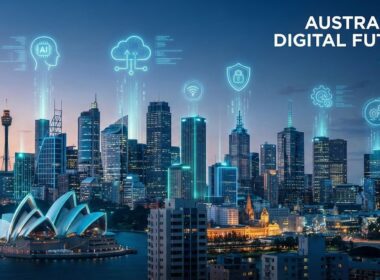Global logistics networks are operating under unprecedented strain. Factors such as fuel price volatility, supply chain disruptions, and rising customer expectations for next-day or even same-day delivery are pushing operational models to their limits.
Artificial intelligence in logistics is moving beyond trial projects and becoming a core part of workflows. It is no longer just a “nice-to-have” innovation; it is essential for making faster, more accurate decisions in environments where delays cost money and inefficiencies compound across thousands of shipments.
In this article, we explore how AI is transforming logistics and transportation to solve specific challenges. We will cover applications such as demand forecasting, route optimization, fleet maintenance, and warehouse management, supported by real-world examples and practical steps for effective adoption.
Key Takeaways
- AI in logistics functions as a decision intelligence layer above TMS/WMS, enabling real-time route changes, predictive maintenance, and warehouse automation.
- Core use cases include predictive demand forecasting, dynamic routing, fleet health monitoring, and computer vision-driven warehouse operations.
- Implementation success depends on data integration across IoT, ERP, and legacy systems, plus model explainability and regulatory compliance.
- Scaling from pilot to production requires infrastructure readiness, operator adoption, and human-in-the-loop controls for high-risk decisions.
- Real-world results include DHL reducing disruption delays, Maersk lowering downtime, and Codewave optimizing fleet utilization through AI consulting.
How AI is Changing the Logistics Landscape
At its core, logistics is about moving goods from point A to point B in the most efficient, predictable, and cost-effective way possible. The challenge is that conditions are constantly changing: demand patterns shift, weather disrupts routes, equipment breaks down, and regulations vary across regions.
AI addresses this by turning the vast streams of operational data generated every second, from GPS trackers, warehouse scanners, ERP systems, IoT sensors, into actionable intelligence. Machine learning models detect patterns and anomalies that humans can’t process at scale, enabling logistics teams to make proactive adjustments instead of reacting to problems after they occur.
The most transformative applications of AI in logistics share three traits:
- Integration across systems, linking data from TMS, WMS, and IoT devices.
- Real-time decision-making, adjusting routes, schedules, and inventory in minutes, not days.
- Predictive capabilities, anticipating failures, bottlenecks, or demand surges before they happen.
With these foundations, AI is no longer just an optimisation tool – it’s becoming a central decision-support system for logistics operations worldwide.
Also Read: Role of AI in Transforming Transportation and Logistics Management
Key Use Cases of AI in Logistics and Transportation
AI in logistics is a suite of targeted capabilities that enhance forecasting, automate repetitive tasks, and enable real-time decision-making. Below are several areas where AI is already delivering measurable results for logistics and transportation companies.
1. Predictive Demand Forecasting
The business problem:
Overestimating demand ties up capital in excess stock and warehousing costs. Underestimating demand leads to stockouts, backorders, and lost sales.
AI-driven approach:
Machine learning models analyse historical sales, seasonality, promotional calendars, and external factors such as economic indicators and weather data. These models can run simulations to forecast demand at SKU, region, or channel level with far greater accuracy than traditional statistical methods.
Example:
Walmart’s AI-powered forecasting system processes over 200 variables to adjust inventory allocation daily, helping reduce overstock and improve on-shelf availability.
Business impact:
- Reduced holding costs
- Improved order fulfilment rates
- Lower write-offs from perishable or obsolete goods
2. Route Optimisation & Dynamic Scheduling
The business problem:
Fuel costs and driver hours are two of the largest operational expenses in logistics. Static route planning can’t adapt to real-time traffic, weather, or shipment delays.
AI-driven approach:
AI combines real-time GPS data, traffic patterns, weather forecasts, and delivery constraints to dynamically adjust routes and schedules. Algorithms can also factor in vehicle capacity and driver shifts to optimise utilisation.
Example:
DHL’s AI-enabled Resilience360 platform analyses disruption data from multiple sources to reroute shipments in real time, cutting delays significantly during weather and infrastructure disruptions.
Business impact:
- Lower fuel consumption
- Reduced late deliveries and penalties
- Better driver productivity
Struggling with late deliveries and rising fuel costs?
Codewave’s AI route optimisation solutions integrate with your existing TMS/WMS to dynamically adjust delivery schedules in real time, reducing fuel consumption and improving on-time performance.
🔗 Start with a 1-week proof of concept and see the impact before you scale.
3. Warehouse Automation & Robotics
The business problem:
Manual picking, packing, and sorting slow throughput, increase error rates, and make scaling up during peak seasons costly and labour-intensive.
AI-driven approach:
AI-powered robots use computer vision to identify, pick, and sort products with minimal human intervention. AI optimises picking routes inside the warehouse to minimise travel time.
Example:
Ocado’s AI-driven fulfilment centres can process thousands of orders per hour using robotic picking arms coordinated by a central algorithm that maps movement down to milliseconds.
Business impact:
- Faster order processing
- Reduced picking errors
- Lower dependency on seasonal labour spikes
Also Read: AI’s Role in Boosting Operational Efficiency
4. Predictive Maintenance for Fleet & Equipment
The business problem:
Unexpected breakdowns disrupt schedules, cause missed deliveries, and lead to high emergency repair costs.
AI-driven approach:
Machine learning models analyse sensor data from engines, brakes, and other vehicle systems to detect early signs of wear or component failure. Predictive maintenance schedules repairs before breakdowns occur.
Example:
Maersk uses AI to predict equipment failures in its shipping fleet, enabling maintenance teams to fix issues during planned port stops rather than during transit.
Business impact:
- Reduced unplanned downtime
- Lower repair and replacement costs
- Extended asset lifespan
Unplanned breakdowns cost more than just repair bills, they can damage customer trust.
Our AI-driven fleet maintenance models predict component wear well before failure, so you can schedule repairs during planned downtime.
🔗 Explore fleet health AI solutions designed for logistics operations.
5. Supply Chain Visibility & Risk Management
The business problem:
When shipments are delayed or lost, it’s often due to issues deep in the supply chain, bottlenecks that traditional tracking systems detect only after the fact.
AI-driven approach:
AI integrates data from freight forwarders, customs, carriers, and IoT sensors to give a live, end-to-end view of shipments. Predictive analytics flags potential delays before they occur, allowing for proactive rerouting or communication with customers.
Example:
IBM’s Sterling Supply Chain platform uses AI to identify weather-related or customs delays in advance, helping logistics teams adjust ETAs and inform stakeholders in real time.
Business impact:
- Fewer surprise delays
- Improved customer trust
- More resilient supply chain operations
Also Read: What is a Digital Supply Chain and Its Key Components
AI in Logistics — Implementation Considerations
AI adoption in logistics can fail quickly if the operational realities aren’t factored in from the start. The biggest gains come when technology, process, and people are aligned, and that requires planning beyond the proof-of-concept phase.
1. Data Quality and System Integration
The challenge:
Logistics data is often fragmented across Transportation Management Systems (TMS), Warehouse Management Systems (WMS), ERP platforms, and IoT devices. Without integration, AI models are trained on incomplete or inconsistent data, leading to inaccurate predictions.
What to consider:
- Conduct a full data audit to identify gaps and overlaps.
- Use API gateways or middleware to connect legacy systems with AI platforms.
- Standardise data formats to make model training consistent.
Why it matters:
Poor data integration can undermine even the most advanced algorithms, leading to wrong routing decisions or inaccurate demand forecasts.
2. Model Explainability and Regulatory Compliance
The challenge:
In industries like transportation and cross-border logistics, AI recommendations, from customs documentation to freight routing, may need to be auditable for compliance purposes.
What to consider:
- Incorporate Explainable AI (XAI) methods to clarify how recommendations are made.
- Maintain audit logs for AI-generated decisions.
- Ensure that the system’s outputs meet local and international regulations.
Why it matters:
A black-box AI system might make highly accurate predictions, but if you can’t explain its logic to a regulator or client, you risk operational delays or non-compliance penalties.
3. Scaling from Pilot to Production
The challenge:
Many AI pilots deliver promising results but fail to scale due to infrastructure bottlenecks, budget overruns, or resistance from operational teams.
What to consider:
- Start with high-impact, low-complexity use cases for early wins.
- Plan infrastructure requirements in advance, both compute capacity and network bandwidth.
- Involve frontline operations staff early to ensure buy-in and adoption.
Why it matters:
A successful small-scale AI deployment that can’t be expanded to a regional or global network wastes both the initial investment and the opportunity for ROI.
4. Human Oversight in AI-Driven Decisions
The challenge:
Fully autonomous decision-making in logistics can lead to errors in exceptional or high-risk scenarios that models haven’t been trained for.
What to consider:
- Keep humans in the loop for exceptions, escalations, and critical routing or safety decisions.
- Provide operators with decision-support dashboards that explain the AI’s recommendation.
- Establish override protocols when human judgment is required.
Why it matters:
AI should enhance human decision-making, not replace it entirely, especially in time-sensitive, safety-critical logistics operations.
Also Read: How Agentic AI is Transforming Supply Chains
Real-World Examples of AI in Logistics
The logistics sector is already home to some of the most advanced AI deployments in any industry. These examples highlight how targeted applications are solving specific operational challenges and creating measurable impact.
1. DHL – AI-Enhanced Supply Chain Resilience
DHL’s Resilience360 platform combines AI-powered risk analysis with real-time supply chain visibility. It monitors geopolitical events, weather systems, and transportation disruptions, recommending alternative routing before delays occur. This proactive approach has helped customers reduce disruption-related costs and improve delivery reliability in volatile markets.
2. Maersk – Predictive ETA and Vessel Maintenance
Maersk integrates AI models with IoT data from its fleet to calculate accurate Estimated Time of Arrival (ETA) for shipments and anticipate equipment maintenance needs. This has reduced unplanned downtime across its vessels and improved scheduling efficiency at ports, lowering demurrage fees.
3. Amazon – Demand Forecasting and Inventory Positioning
Amazon applies deep learning models to forecast regional demand weeks in advance. This allows them to pre-position inventory in strategically located warehouses, shortening delivery times and reducing transportation costs – a critical edge in same-day and next-day delivery markets.
4. Ocado – Fully Automated Fulfilment Centres
Ocado’s AI-controlled fulfilment centres coordinate thousands of robots that pick, pack, and sort grocery orders. Machine learning optimises routing inside the warehouse, reducing fulfilment times and ensuring inventory accuracy even during demand surges.
5. Codewave – Intelligent Fleet and Operations Management
In a recent logistics digitisation project, Codewave applied AI/ML algorithms to analyse fleet utilisation patterns, delivery timelines, and driver schedules. The solution identified underperforming routes and optimised scheduling, resulting in reduced fuel consumption and higher on-time delivery rates. You can explore similar projects in our portfolio.
Codewave’s AI Consulting and Implementation Services for Logistics
For logistics companies, AI adoption isn’t just about installing new tools — it’s about aligning technology with operational realities, regulatory requirements, and measurable business goals. Codewave’s AI consulting services are designed to help logistics leaders move from concept to production with speed, clarity, and confidence.
Our logistics-focused capabilities include:
1. AI Strategy and Readiness Assessment
- Map AI opportunities to specific logistics KPIs such as on-time delivery rate, fuel efficiency, and order accuracy.
- Audit existing data streams from TMS, WMS, ERP, and IoT devices to assess integration readiness.
- Define governance, explainability, and compliance frameworks.
🔗 Explore AI Strategy Consulting
2. Rapid Proof of Concept (Done in a Week)
- Validate AI models for route optimisation, demand forecasting, or predictive maintenance in five working days.
- Minimise risk and cost of experimentation by running small-scale pilots before scaling.
3. Custom AI Model Development and Integration
- Build ML models tuned for logistics contexts, from anomaly detection in shipment flows to real-time capacity forecasting.
- Integrate seamlessly with existing TMS/WMS platforms through secure API layers without disrupting daily operations.
🔗 Explore AI & Machine learning development Services
4. Generative AI and Decision Support Systems
- Implement AI-powered dashboards for fleet managers, warehouse supervisors, and supply chain planners.
- Create explainability layers so operators can see why the AI recommends a certain action.
5. Ongoing Monitoring and Optimisation
- Track model drift, operational KPIs, and ROI post-deployment.
- Fine-tune algorithms to adapt to changing demand patterns, regulatory updates, and emerging risks.
See what we’ve built: Codewave has delivered AI-driven logistics digitisation projects that reduced fuel consumption, improved on-time delivery, and optimised fleet utilisation across regional and global operations. Explore our portfolio for detailed case studies.
Conclusion
AI in logistics has evolved from experimental pilots to mission-critical systems that underpin competitive advantage. From predicting demand spikes and optimising routes to automating warehouses and anticipating equipment failures, AI is reshaping how goods move across the globe.
Yet, technology alone is not the differentiator, it’s the alignment of AI with business priorities, operational constraints, and human oversight that turns algorithms into real-world performance gains.
For logistics leaders, the choice is no longer whether to adopt AI, but how to adopt it in a way that scales, complies, and delivers measurable ROI.
This is where Codewave comes in — helping you identify the highest-impact use cases, validate them quickly, and integrate AI into your operations with minimal disruption and maximum transparency. Whether you’re starting with a proof of concept or looking to roll out AI across your entire logistics network, we bring the strategy, technical expertise, and design thinking to make AI work for you.
Ready to Build AI-Driven Logistics That Deliver?
From predictive demand forecasting to autonomous warehouse operations, Codewave helps logistics companies turn AI from a buzzword into a bottom-line driver.
Start with a proof of concept in just one week, or schedule a strategy consultation to explore your highest-ROI opportunities.
Let’s talk about your AI journey → Contact Codewave
FAQs: Artificial Intelligence in Logistics
Q1. How is AI in logistics different from traditional automation?
Traditional automation follows pre-defined rules and schedules, while AI adapts to changing conditions in real time. For example, a traditional system might trigger the same route plan daily, whereas an AI system will re-route shipments instantly if it detects a traffic accident, weather delay, or warehouse bottleneck.
Q2. Is AI adoption in logistics only feasible for large enterprises?
No. While global carriers may deploy AI at massive scale, small and mid-sized logistics companies can start with targeted use cases like demand forecasting or fleet maintenance. Cloud-based AI platforms make entry costs more manageable, enabling smaller players to compete on efficiency.
Q3. How long does it take to see ROI from AI in logistics?
For focused use cases with clean, integrated data, companies often see measurable results, such as reduced delivery times or fuel costs, within 3–6 months. Broader, multi-function deployments may require 12–18 months for full ROI.
Q4. What skills are needed in-house to manage AI in logistics?
While you don’t need a large AI engineering team, you do need:
- Data analysts familiar with logistics KPIs
- IT staff for integration and system monitoring
- Operational leaders trained to interpret AI recommendations
Many companies partner with AI consultants for the design and initial deployment, then manage day-to-day oversight internally.
Q5. Can AI in logistics help meet sustainability goals?
Yes. AI can optimise routes to reduce fuel usage, balance load capacity to minimise trips, and forecast demand to avoid overproduction. Some systems also factor carbon emissions into route planning, helping logistics providers track and reduce their environmental impact.
Q6. How does AI in logistics work with cross-border compliance?
AI can be trained to flag documentation errors, detect compliance risks, and adapt workflows for different customs regulations. This reduces clearance delays and fines, especially in high-volume international shipping operations.
Codewave is a UX first design thinking & digital transformation services company, designing & engineering innovative mobile apps, cloud, & edge solutions.







